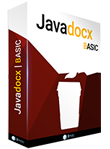Practical javadocx
Set-up, download and configuration
javadocx is a software library designed to generate dynamic DOCX documents. It allows to create documents from scratch, using MS Word templates, where you can add texts, tables, images, graphic charts, sections and so on, import HTML/CSS content, transform to PDF and many other features.
The document generation tasks, as well as template working and conversion plugin features, are fully compatible with Linux, Windows and macOS operating systems, and also other Java environments.
Whether it is necessary to create a single document or hundreds of thousands, javadocx is the perfect tool.
All javadocx paid licenses are open source, meaning that it is possible to modify the code of all classes. Software redistribution is not allowed.
javadocx is a Java code programmed proprietary product. There are three available versions:

Basic
This elementary license generates documents, works with templates, and converts HTML and CSS to DOCX.
It allows to use the data library in a sub-domain, for example www.domain.com or docs.domain.com.

Advanced
In addition to the Basic license features, this version includes merging methods, watermark classes, the conversion plugin to convert DOCX to PDF, ODT and other multiple format files, DOCXPath features and other extra methods and classes.
You'll be able to use the data library in one domain and all its subdomains, for example www.domain.com and any other subdomain (*.domain.com) such as intranet.domain.com and docs.domain.com

Premium
In addition of the Advanced license features, this version offers DOCXCustomizer to change styles on-the-fly, digital signature and encryption features, and other extra options to get the best performace.
It allows to use the data library in an IP, and all the domains it serves, or a domain and all its subdomains.
Besides executing it in the subdomain/domain or IP address acquired, the three licenses allow you to execute javadocx in localhost and private networks (classes A, B and C).
javadocx set up is really simple. After purchasing the chosen license, download the ZIP package from the MY JAVADOCX page and copy the files to the path where you will use the library.
You can extract this package with any extracting tool or a graphic application like Xarchiver, WinZip or WinRAR.
For Linux, execute the following command in a terminal:
Replacing javadocx.zip with the downloaded package name.
After extracting the content of the package, you'll see the following files and directories:
- .classpath: Eclipse default settings
- .projects: Eclipse default project.
- .settings: classpath entries.
- dist: JAR file. Compiled using Java 8. Purchased licenses can compile a new JAR using other JDK versions with the included classes (src folder).
- doc: javadoc files.
- FaqsAndDocs.txt: Documentation links.
- libs: External JAR packages.
- LICENSE: License file.
- Readme.txt: Version information and change log.
- src: source code classes and samples. The trial package doesn't include the source code classes.
The included files allow to easily import javadocx in Eclipse, either as an independent project or integrating it in a pre-existing one.
To add javadocx as a new project, first unzip the ZIP file that contains the library. Open Eclipse and go to the option File->Import. Now choose General->Projects from Folder or Archive. Then select the folder where the javadocx unzipped files are and click Finish. This adds the library to the Workspace as a new project, where you will be able to execute the included examples or create brand new ones.
In order to incorporate javadocx to pre-existing projects it is enough to import the javadocx JAR and its dependencies, in the event of these dependencies not being already available in the project.
Non UTF8 characters
The final MS Word documents have to be UTF-8 encoded and non UTF-8 characters may break the final document.
